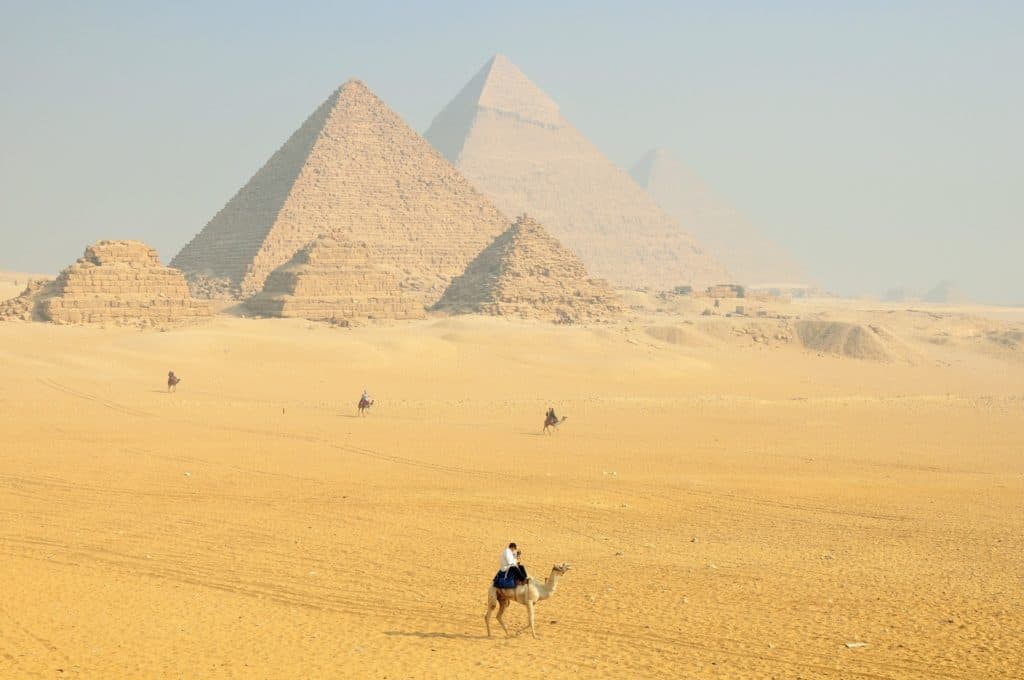What You Didn’t Know about the Pyramids of Giza

Updated On: March 09, 2024 by Dina Essawy
The Pyramids of Giza are a timeless testament to ancient Egypt’s ingenuity, craftsmanship, and cultural prowess. These monumental structures have captivated the imagination of humanity for millennia, serving as an enduring symbol of power, mystery, and the mysteries of the afterlife. While they are among the most iconic landmarks on Earth, there is much more to these enigmatic edifices than meets the eye. Delving deeper into their history, construction, and significance unveils a tapestry of secrets that intrigue scholars and enthusiasts alike.
The Importance of the Afterlife
The ancient Egyptians believed strongly in life after death. So, they did all in their power to prepare for what was to come. Building temples and shrines were part and parcel of their religious beliefs. The ancient Egyptians believed the soul would return to its body in the afterlife, so the body had to be correctly preserved through mummification.
Then, the bodies would be placed in the tombs and the shrines, along with their worldly belongings. It makes sense that kings and queens would not be buried in tombs similar to those of the people they governed.
It almost seems like the Pharaohs competed to see who would build the most enormous tomb.
The Construction of the Pyramids of Giza

Constructed over 4,500 years ago during the Old Kingdom period of Ancient Egypt, the Pyramids of Giza represent a remarkable feat of engineering prowess. The three main pyramids, built for the pharaohs Khufu, Khafre, and Menkaure, were meticulously designed to serve as eternal resting places and monuments to their divine rulers. What sets these pyramids apart is their sheer size and the precision with which they were built.
The Great Pyramid of Khufu, also known as the Pyramid of Cheops, is the largest and most famous of the three. Its construction required an estimated 2.3 million limestone blocks weighing several tons. Remarkably, these blocks were transported from quarries located miles away and assembled with astonishing accuracy, with some fitting together so tightly that not even a sheet of paper could slide between them.
The precise methods used by ancient Egyptians to achieve such feats of construction remain a subject of fascination and debate among historians and archaeologists. While some theories suggest the use of ramps, others propose more innovative techniques, such as the use of counterweights and levers. Regardless of the exact methods employed, the Pyramids of Giza stand as a testament to the advanced engineering capabilities of ancient civilizations.
A Cosmic Connection
Beyond their impressive engineering, the Giza Pyramids also have a mysterious connection to the cosmos. Many scholars believe that the layout of the pyramids is aligned with astronomical phenomena, such as the positions of certain stars and constellations. For example, the orientation of the Great Pyramid is said to be closely aligned with the cardinal points of the compass, while its sides are believed to correspond to the four cardinal directions.
One of the most intriguing theories surrounding the pyramids is that they were built as a reflection of the stars. The alignment of the three main pyramids is often compared to the three stars of Orion’s Belt, a prominent constellation in the night sky. This has led some to speculate that the ancient Egyptians intended the pyramids to serve as earthly representations of the celestial realm, perhaps as a means of facilitating the pharaoh’s journey to the afterlife.
The significance of these cosmic alignments remains a subject of speculation, with some suggesting that they may have held religious or symbolic importance for the ancient Egyptians. Whatever the case, the connection between the pyramids and the stars serves as a reminder of the profound relationship between humanity and the cosmos throughout history.
The Mystery of the Sphinx
Without mentioning the enigmatic Sphinx, no discussion of the Pyramids of Giza would be complete. Carved from a single limestone block, this colossal statue depicts a mythical creature with a lion’s body and a human’s head. Standing at over 20 meters tall and 73 meters long, the Sphinx is one of the world’s most giant and most recognizable statues.
Despite its prominence, the Sphinx’s origins and purpose remain in mystery. While it is commonly believed to have been built during the reign of Pharaoh Khafre, the exact date of its construction and the identity of the figure it represents are subject to debate. Some scholars argue that the Sphinx may have originally represented the sun god Ra. In contrast, others suggest that it may have been intended as a guardian or protector of the pyramids.
Adding to the mystery are the numerous legends and myths that have emerged surrounding the Sphinx over the centuries. From tales of hidden chambers and lost treasures to theories of extraterrestrial influence, the Sphinx continues to captivate the imagination of historians, archaeologists, and conspiracy theorists alike.
Changes over Time
In ancient Egypt, the Great Pyramid was more than just a monument. The ancient Egyptians called it “Ikhet,” meaning the “Glorious Light”, as it was initially covered with polished limestone that reflected the sun’s light and made the pyramid shine like a jewel. However, after an earthquake that took place in the 14th century loosened these shining stones, they were used by Arabs to build mosques.
More than Just Places of Burial
The Pyramids of Giza are far more than just burial grounds for the Pharaohs who ordered their construction. The walls of the Pyramids feature drawings and illustrations that showcase every aspect of life in ancient Egypt.
Peter Der Manuelian, Museum of Fine Arts, Boston, and Tufts University Egyptologist, says, “Many people think of the site as just a cemetery in the modern sense, but it’s a lot more than that. In these decorated tombs, you have wonderful scenes of every aspect of ancient Egypt—so it’s not just about how Egyptians died but how they lived. Almost any subject you want to study about Pharaonic civilisation is available on the tomb walls at Giza.”
The Astronomical Position of the Pyramids
Robert Bauval, a Belgian author, lecturer, and Ancient Egypt researcher, came up with the Orion Correlation Theory in which he claimed that the three Great Pyramids of Giza are intentionally positioned in alignment with the three main stars of the constellation Orion’s Belt.
It is no secret that the ancient Egyptians were quite advanced in many fields of science, not the least of which was astronomy, so this theory is no surprise.
The Great Pyramid Has 8 Sides Not 4
A discovery was made by a British pilot in 1940 that each of the four sides of the Great Pyramid was split in two by a concave and very precise indentation. This indentation is only visible from the air at dawn and sunset on the spring and autumn equinoxes when the sun casts shadows on the pyramid.
The Temperatures inside the Pyramids
Archaeologists have discovered that no matter how hot the temperature might get outside, the temperatures within the pyramids remain constant at around 20 degrees Celsius. This adds to the mysteries of the architectural designs of the pyramids that scientists have yet to uncover.
The Perishing Wonders of the World
It is a well-known fact that the Great Pyramid is the only remaining ancient wonder. It was previously joined by relics and monuments such as the Lighthouse of Alexandria, the Mausoleum at Halicarnassus, the Temple of Artemis at Ephesus, the Hanging Gardens of Babylon, the Statue of Zeus at Olympia, and the Colossus of Rhodes.
Unlocking the Secrets
Despite centuries of study and exploration, the Pyramids of Giza reveal new secrets and insights into the ancient world. Recent technological advances, such as ground-penetrating radar and 3D scanning, have allowed researchers to uncover hidden chambers and passageways within the pyramids, shedding light on their construction and purpose.
One of the most significant discoveries in recent years was identifying a previously unknown void within the Great Pyramid. Dubbed the “ScanPyramids Big Void,” this mysterious space was detected using cosmic-ray muon radiography. This non-invasive technique allows researchers to image the interior of structures without causing damage. While the exact nature of this void remains a subject of speculation, some experts believe it may hold clues to the pyramid’s construction or function.
In addition to technological advancements, ongoing archaeological excavations and research projects provide new insights into the lives of the people who built and inhabited the pyramids. From the discovery of workers’ villages and tombs to the analysis of ancient artefacts and inscriptions, these efforts are helping to paint a more detailed picture of life in ancient Egypt and the role of the pyramids within society.
Conclusion
The Pyramids of Giza stand as a testament to the ancient Egyptians’ ingenuity, skill, and vision. From their awe-inspiring scale to their mysterious cosmic alignments, these monumental structures continue to captivate and inspire people worldwide. While much remains unknown about their construction and purpose, ongoing research and exploration gradually unravel the secrets of these enigmatic edifices, offering new insights into the ancient past and the enduring legacy of one of humanity’s most outstanding achievements.
Have you ever visited the Pyramids of Giza? Let us know your thoughts in the comments below:
More Amazing Egyptian Blogs: Al Azhar Park Cairo | Egyptian Food, Blended from Other Cultures | Egypt’s Hidden Gems, Beat El Shemy | Ramadan Month in Cairo






